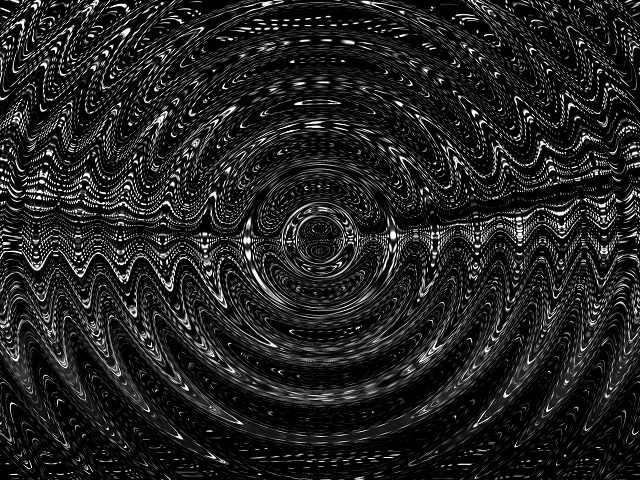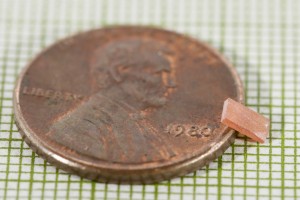
Image Credit: optimarc | Shutterstock.com
Researchers at Princeton University have performed an experiment which has demonstrated the Hall Effect in a group of quantum materials known as 'frustrated magnets'.
This latest breakthrough will provide an insight into the nature of these discontented magnets and may pave the way for the next-generation electronic materials.
 A crystal of frustrated magnet (Tb2Ti2O7). Image credit: Jason Krizan.
A crystal of frustrated magnet (Tb2Ti2O7). Image credit: Jason Krizan.
This research may also help to explain the theory of high-temperature superconductivity, which involves the frictionless transmission of electrical current.
The researchers made this surprising discovery when they tested this unique group of materials to see if they displayed the Hall Effect.
When a magnetic field is applied to an electric current, while it is passing through a copper ribbon, it will be observed that the current will flow to one part of the ribbon.
This deflection was initially discovered by E.H. Hall in 1879 and today it is used in sensors for automobile anti-lock braking systems and computer printers.
As the Hall Effect normally occurs in charge-carrying particles, it was assumed that it would be not be possible to view such kind of behavior in neutral or non-charged particles, similar to those seen in frustrated magnets.
However, a number of theorists contemplated that under very cold conditions, the non-charged particles present in the frustrated magnets may bend to the Hall rule. Under this rule, particles behave as per the laws of quantum mechanics and not according to the traditional physical laws that are seen in on a daily basis. As a result, the quantum behavior can be exploited to redefine both electronic and computing devices.
The research team on this project included N. Phuan Ong, Robert Cava, Russell Wellman Moore, Jason Krizan and Max Hirschberger. The team decided to address the long-debated question by demonstrating that frustrated magnets indeed display the Hall Effect.
In order to show this phenomenon, the researchers used a group of magnets dubbed as pyrochlores. These magnets include magnetic moments which at near absolute zero temperature must organize themselves in a systematic way so that all their spins are focused on the same direction. However, experiments have demonstrated that the spins point in haphazard directions. These discontented materials are called quantum spin ice.
To talk about the Hall Effect for neutral particles is an oxymoron, a crazy idea. These materials are very interesting because theorists think the tendency for spins to align is still there, but, due to a concept called geometric frustration, the spins are entangled but not ordered.
N. Phuan Ong, Eugene Higgins Professor of Physics
One major property of quantum systems is entanglement. The research team is planning to exploit this property to design a quantum computer. Such a computer would help in solving key problems which otherwise would not be possible by present-day computers.
A chance discussion between Ong and Cava showed that Cava had the required experimental infrastructure and knowledge to develop such kind of materials and there upon he tasked Krizan and Hirschberger, chemistry graduate student and physics graduate student, respectively to organize the experiments required to search for the Hall Effect.
The experiments were carried out at 0.50 K. Hirschberger was also tasked to resolve temperature variations down to thousandth of a degree between the reverse edges of a crystal.
The main challenge was how to measure the Hall Effect at an extremely low temperature where the quantum nature of these materials comes out.
Max Hirschberger, Graduate Researcher
In order to grow the crystals, Krizan produced the material from titanium oxide and terbium oxide in a furnace, which resembled a kiln. Once the pyrochlore powder was formed into a cylinder, which was perfect for feeding the crystal growth, the same was suspended in a chamber packed with pure oxygen.
The cylinder was then blasted with adequate amount of focused light from four 1000 Watt halogen light bulbs to heat a small area to 18000 oC. The outcome was flat, thin, transparent or orange slabs that measured the size of a sesame seed.
Next, each crystal was tested by attaching small gold electrodes to both ends of the slab. This was done by using microheaters to pass a heat current via the crystal. Under very low temperatures, this heat current is similar to the electric current observed in the normal Hall Effect experiment.
Simultaneously, a magnetic field was applied in the path perpendicular to the heat current. Hirschberger observed that the heat current was deflected to one part of the crystal and this way the Hall Effect was observed in a non-magnetic material.
Hirschberger performed the experiment again, but this time he reversed the heat current’s direction. In case the Hall Effect is actually observed, the current would deflect to the other side of the crystal. At such low temperatures, it was quite difficult to reconfigure the experiment, but in the end the signal reversed in a way that was consistent with the Hall Effect.
All of us were very surprised because we work and play in the classical, non-quantum world. Quantum behavior can seem very strange, and this is one example where something that shouldn’t happen is really there. It really exists.
N. Phuan Ong, Eugene Higgins Professor of Physics
According to him, experiments used to explore the quantum behavior of different types of materials are important to gain a better insight into the basic physical properties and thereby the ultimate exploitation of this knowledge in novel technologies.
"Every technological advance has a basis in fundamental science through our curiosity about how the world works," added Cava.
Additional studies on these materials can provide a better understanding on how superconductivity takes place in cuprates, which are copper-containing materials also called as high-temperature superconductors. These materials are capable of working well beyond the cold temperatures needed for present-day’s superconductors, like those employed in MRI systems.
A major concept of how high-temperature superconductivity can take place is based on the probable existence of a quasiparticle, known as a spinon. According to Joseph Henry, Professor of Physics at Princeton University, spinons may possibly be the carrier of a heat current in a quantum machine like the one studied in this study.
Ong added that the study does not claim to have observed the spinon, but it may possibly lead to that direction in the forthcoming days. "This work sets the stage for hunting the spinon. We have seen its tracks, so to speak," concluded Ong.
The study has been published in the journal Science.